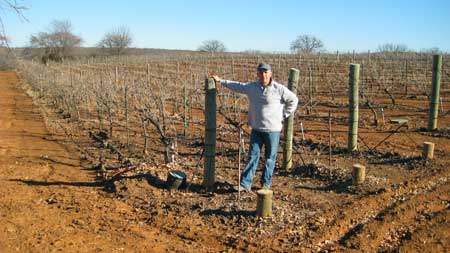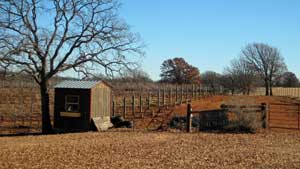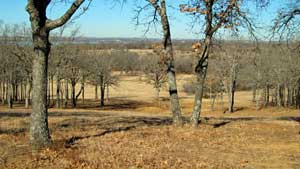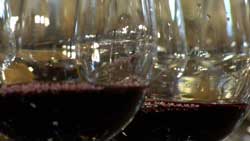
North Texas Road Trip: Entry 6 – Lone Oak Vineyard, a bit of Texas Bordeaux
I stopped the previous night in Denton, Texas. This morning I awoke and primed for today’s adventure with a “stick-to-my-ribs” Waffle House breakfast. Over the period of a couple days since the cold and ice hit northeast Texas, the weather was warming agreeably. Saturday raised its fresh and sunny face. The morning sun cast a warm, amber hue on the dry countryside punctuated only by occasional fields of emerald green winter rye.
As mentioned at the start of this trip (A Frosty Morning at Kiepersol Winery – https://vintagetexas.com/?p=472), the path of my road trip mostly paralleled the shoreline of the ancient inland sea from Cretaceous times, 60 to 120 million years ago. North of Dallas, this epoch and subsequent erosion produced rich red sandy soils underlaid by sandstone and limestone. I approached the state line and its defining Red River revealed the repeated cut of erosion down into limestone bedrock, leaving a mineral-rich alluvial soil as it incised its meandering way across the north Texas prairie.
Bordeaux Texas
My morning destination was about a half hour north of Denton toward the Oklahoma line where I visited with Robert Wolf at his Lone Oak Vineyard near Valley View, Texas. This vineyard was of particular interest to me as it was started in the mid-1990s by Robert and Jamie Wolf as a bit of Texas Bordeaux. While most people acknowledge that Texas is not Bordeaux, this effort was most impressive and I wanted to better understand its development.
First of all, Lone Oak Vineyard was based on the concept of high density of vines gained through a spacing scheme similar to that used in Bordeaux versus the much lower density common in California vineyards. The high density spacing yielded an almost ten-fold increase in the number of vines in the same amount of land. Some say that this approach adds an element of competition to the vine’s apparent simple life that stimulates better fruit production and retards vegetative growth.
Secondly, the vineyard was fundamentally based on Bordeaux varietals. It consisted of mostly Merlot with some Cabernet Sauvignon, Petit Verdot and Cabernet Franc with the goal of producing either single varietal Merlot or Cabernet, or Meritage-style blends (http://www.meritagewine.org).
Bordeaux-Style Wines
For those not totally familiar with Bordeaux-style wines, they are commonly composed of two or more of five commonly used grape varietals: Cabernet Sauvignon, Merlot, Cabernet Franc, Petit Verdot, and Malbec. You may have seen red wines and blends in this style from premium wine producers. Other wineries use proprietary names for red Bordeaux or Meritage blends, such as Opus One, Insignia, and Quintessence, while still others use single varietal designations since their wines contain over 85 percent of one primary Bordeaux grape variety.
The blending of Bordeaux varietals is designed to achieve the best of qualities available from the individual varietals in a blended wine. For example, Cabernet Sauvignon is used for its tannic structure (sometimes called “backbone”), Merlot for roundness or softness, Cabernet Franc for color and complexity, Malbec for body and mouth feel, and Petit Verdot for aroma and color. Conventionally, this approach gives Bordeaux winemakers a full “palatte” of red wine qualities to create their wines. At Lone Oak Vineyard, Robert and Jamie staked a Bordeaux claim in Texas.
Above all, the purpose of this visit was to view this vineyard and to talk to Robert following my previous tour stop with Les Constable where Les highlighted some of the difficulties transplanting the Bordeaux wine experience to Texas at particular to his locations (Visiting the Supreme Expérimenter at Brushy Creek Vineyard – https://vintagetexas.com/?p=512). He alluded to the fact that it was not only soil dependent.
Vineyard Walk
 I joined Robert at Lone Oak Vineyard and we walked and talked in the morning sun. While approaching the vineyard, ducks on the pond took flight. As we stopped briefly to observe, Robert mentioned, “In addition to irrigating the vineyard, the ponds have the added benefit of attracting water fowl.” He punctuated this comment with, “But as with many things necessary in starting a vineyard, they get done backwards.” In this case, Jamie and Robert anticipated using well water for the vineyard, but their well was too sodium-rich for grapes. They would have needed to drill down to 1600 ft to the Upper Trinity aquifer to get adequate water. This being prohibitive, they decided as a secondary plan of action to develop the ponds to retain rain water for irrigation. Robert said, “So far the ponds have worked well, but this exercise taught us that water should have been one of our first (and not second) considerations in starting a vineyard.”
I joined Robert at Lone Oak Vineyard and we walked and talked in the morning sun. While approaching the vineyard, ducks on the pond took flight. As we stopped briefly to observe, Robert mentioned, “In addition to irrigating the vineyard, the ponds have the added benefit of attracting water fowl.” He punctuated this comment with, “But as with many things necessary in starting a vineyard, they get done backwards.” In this case, Jamie and Robert anticipated using well water for the vineyard, but their well was too sodium-rich for grapes. They would have needed to drill down to 1600 ft to the Upper Trinity aquifer to get adequate water. This being prohibitive, they decided as a secondary plan of action to develop the ponds to retain rain water for irrigation. Robert said, “So far the ponds have worked well, but this exercise taught us that water should have been one of our first (and not second) considerations in starting a vineyard.”
We then talked about the 15+ year experience at Lone Oak Vineyard and his efforts to develop Bordeaux-style wines. In our discussion, Robert and I immediately focused on additional elements of terroir beyond soil as a key to the vineyards success.
More Micro-Climate the Better
 The vineyard’s proximity to Lake Ray Roberts was apparent. It was surrounded on three sides by the lake and it came as close as one mile to the vineyard. Robert said, “The intimate proximity of the lake combined with the prevailing summer wind out of the southwest results in a cooling effect for the vineyard. We actually oriented the vineyard to take advantage of the lake effect. We see later bud break in the spring that gives this vineyard a little more resistance to the late spring freezes so common in this part of Texas. We also see our grapes ripen two to four weeks sooner than other locales to the west of us that do not have the lake effect.”
The vineyard’s proximity to Lake Ray Roberts was apparent. It was surrounded on three sides by the lake and it came as close as one mile to the vineyard. Robert said, “The intimate proximity of the lake combined with the prevailing summer wind out of the southwest results in a cooling effect for the vineyard. We actually oriented the vineyard to take advantage of the lake effect. We see later bud break in the spring that gives this vineyard a little more resistance to the late spring freezes so common in this part of Texas. We also see our grapes ripen two to four weeks sooner than other locales to the west of us that do not have the lake effect.”
The Lone Oak Vineyard summertime microclimate from the lake effect reduces daytime temperatures. These lower temperatures reduce the tendency for the Bordeaux varietals in his vineyard to shut down and stop ripening due to excessive summer heat. He mentioned that the only one of the Bordeaux varietals that has not so far responded well was the Cabernet Franc, but Robert continues to work with it.
The vineyard is conveniently located only a few steps from the house. Rows of Cabernet Sauvignon start at the bottom of the vineyard and give way to more rows of Merlot in the heart of the vineyard where the vineyard has the deepest soils. Robert referred to these Merlot vines as “the real workhorse of the vineyard. They have consistently put out high quality fruit.” He has also included additional rows of Cabernet Franc and Malbec, and is now up to five rows of Petit Verdot. Robert is particularly fond of the way the Petit Verdot has responded. As he pointed out, “We have good success with Merlot and Cabernet at our location, but the Petit Verdot is particularly impressive as it adds a lot of character and aroma.”
Now that both Robert and the vineyard have matured a bit, he has recently started to open the vineyard up by removing a few low productivity rows. This has made it more convenient for getting into and working the vineyard with mechanized equipment.
Another obvious aspect upon viewing the Lone Oak Vineyard was its excellent soil structure. It is an alluvial mix of sand and sandstone gravel held together with just the right amount of clay for an excellent consistency and drainage. The most impressive aspect of the vineyard soil is the characteristic iron-rich, red color common to the dirt along the nearby and aptly named Red River.
Lone Oak Meritage Blending
 Before leaving, Robert took me inside and we tasted from three oak barrels where he was aging a small amount of wine from his 2008 vintage. Based on our tasting, we assembled our own 2008 Lone Oak Meritage blend and he made a single bottle for me to take with me. Our barrel tasting confirmed the added benefit of the Petit Verdot in the blend of Cabernet Sauvignon and Merlot which exhibited a noticeably more complex aroma along with a youthful, purple color.
Before leaving, Robert took me inside and we tasted from three oak barrels where he was aging a small amount of wine from his 2008 vintage. Based on our tasting, we assembled our own 2008 Lone Oak Meritage blend and he made a single bottle for me to take with me. Our barrel tasting confirmed the added benefit of the Petit Verdot in the blend of Cabernet Sauvignon and Merlot which exhibited a noticeably more complex aroma along with a youthful, purple color.
Over the next few evenings, I tasted this blend and it revealed an incredibly pleasing and palatable experience that improved daily as the aromas and flavors melded in the bottle. They would have undoubtedly benefited with further age; but alas, one bottle can only go so far.
+++++++++++++++++++++++++++++++++
Next Up: A Visit with Gene Estes at Lone Oak Winery in Burleson, Texas

Russ, thank you so much for the way you dig down to understand Texas viticulture. We at Lone Oak winery are so pleased to continue to have these wine grapes from Robert and Jamey Wolf. We have great years and not so great years, but it is clear that Robert and Jamie are totally focused on quality and that is what we emphasize. We could not make it without their devotion to our goals.
Gene,
Thanks for the comments. Unlike a lot of wine writers, I have always tried to understand what leads up to getting quality wine in the glass going back to the roots in the vineyard.
With respect to Texas grape growing, I find the historical and agriculture prespective extremely interesting and very important to understand to have a better appreciation of where we have been and where we are going in the Texas wine experience.
Russ Kane